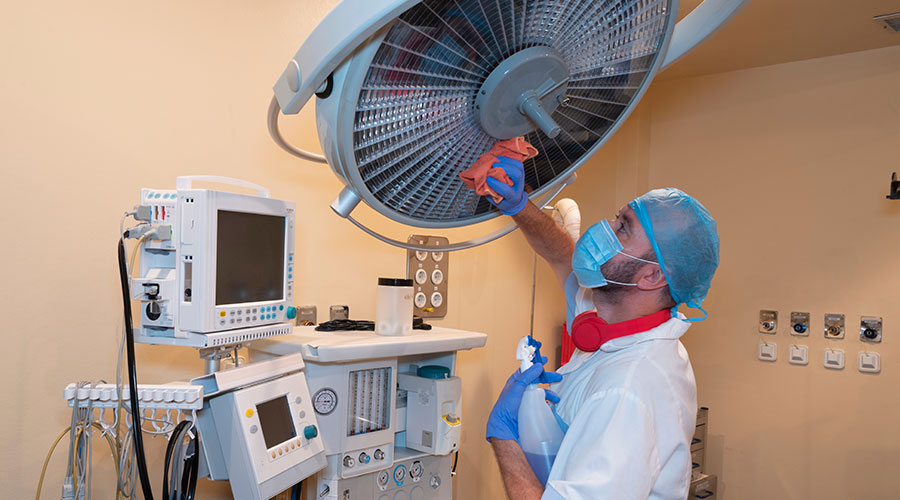Each year, at least 1.7 million adults in America develop sepsis. Over 3 million patients died in America’s hospitals in 2023, and one in three people who dies in a hospital had sepsis during that hospitalization. These statistics mean that 1 million people in the United States died from or with sepsis, and that sepsis is a 'big brother' to healthcare-associated infections (HAI) that cause at least 99,000 deaths each year.
Sepsis is the body’s extreme response to an infection. It is a life-threatening medical emergency that happens when an existing infection triggers a chain reaction throughout the body. Although many sepsis cases originate from infections acquired during hospitalization, sepsis is recorded and budgeted separately from HAI. This reporting means its impact adds to the overall burden of HAI but is often not reflected in the statistics.
A comprehensive meta-analysis — Markwart, et al., 2020 — found that approximately 23.6 percent of all sepsis cases in hospitals — and 48.7 percent of those with organ dysfunction in intensive care units — were hospital-acquired. But more recent data suggest that the true burden is even greater: A 2024 review by Garvey reports that up to 49 percent of sepsis cases with organ dysfunction are hospital-acquired, and that hospital-acquired sepsis (HAS) might account for up to 50 percent of all sepsis-related deaths (Garvey, Int. J. Mol. Sci., 2024).
Cleaning is a science, and an increasing body of evidence demonstrates that environmental cleaning is an essential yet complex component for the prevention of HAI-induced sepsis. Recognizing and addressing the challenges staff encounter through comprehensive education and ongoing training reinforces correct practices and reduces variability in implementation. Investment in hospital cleaning also must reflect appreciation and tangible support for the vital role environmental services (EVS) staff play in hospital patient safety.
Top performing EVS departments have less to do with the right products, policies and people and much more to do with the leadership culture. Beautiful policies are not always reflected in the performance of the tasks of cleaning and disinfecting a patient’s room and restroom. I’ve seen visibly dirty, unsanitary, and unacceptable patient rooms in one of the nation’s so-called top 10 hospitals.
A great culture of leadership includes daily huddles for starters. When it comes to cleaning and disinfecting the patient’s environment, managers need to pay attention to detail, provide coaching, and articulate success. Daily huddles — also known as pre-shift meetings — are brief, structured and designed to align team members and address potential challenges at the start of each workday. They promote communication, boost team momentum and ensure everyone is on the same page.
Successful EVS programs include leadership rounds. The purpose of rounding on team members during their daily tasks is to foster a culture of communication, engagement and continuous improvement within the hospital. It involves regular, structured visits to interact with staff, build relationships, gather feedback and address concerns or issues they might have. This practice helps managers understand the daily realities of their team, identify potential problems early and praise the efforts of the team member to a patient or visitor.
Investing in hospital cleaning also must reflect appreciation and tangible support for the vital role cleaning staff play in the prevention and control of HAIs.
J. Darrel Hicks, BA, MESRE, CHESP, Certificate of Mastery in Infection Prevention, is the past president of the Healthcare Surfaces Institute. Hicks is nationally recognized as a subject matter expert in infection prevention and control as it relates to cleaning. He is the owner and principal of Safe, Clean and Disinfected. His enterprise specializes in B2B consulting, webinar presentations, seminars and facility consulting services related to cleaning and disinfection. He can be reached at darrel@darrelhicks.com, or learn more at www.darrelhicks.com.

 Grounding Healthcare Spaces in Hospitality Principles
Grounding Healthcare Spaces in Hospitality Principles UC Davis Health Selects Rudolph and Sletten for Central Utility Plant Expansion
UC Davis Health Selects Rudolph and Sletten for Central Utility Plant Expansion Cape Cod Healthcare Opens Upper 2 Floors of Edwin Barbey Patient Care Pavilion
Cape Cod Healthcare Opens Upper 2 Floors of Edwin Barbey Patient Care Pavilion Building Sustainable Healthcare for an Aging Population
Building Sustainable Healthcare for an Aging Population Froedtert ThedaCare Announces Opening of ThedaCare Medical Center-Oshkosh
Froedtert ThedaCare Announces Opening of ThedaCare Medical Center-Oshkosh